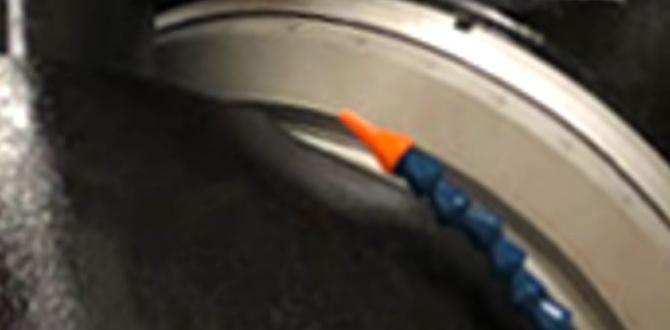Get stunning precision when machining mild steel with a carbide end mill! Learn how to select the right tool, set up your machine, and achieve clean cuts for tight tolerances. This guide makes it simple for beginners.
Welcome to Lathe Hub! Are you struggling to get smooth, accurate cuts in mild steel? It can be frustrating when your parts aren’t coming out just right, especially when you’re aiming for that perfect, tight tolerance. Many beginners find that traditional end mills can “hog out” material or leave a rough finish on steel. But don’t worry, there’s a powerful solution that gives you incredible control and precision: the carbide end mill. In this guide, we’ll break down exactly how to use a carbide end mill to achieve those beautiful, accurate results in mild steel. Get ready to take your machining skills to the next level!
Why Carbide End Mills Are Your Secret Weapon for Mild Steel
Mild steel is a workhorse material, common in countless projects. However, it can be a bit tricky to machine. It’s tougher than aluminum but softer than hardened steels, meaning it can easily cause tools to wear out quickly or produce a poor surface finish. This is where carbide end mills shine.
Carbide, specifically tungsten carbide, is an incredibly hard and wear-resistant material compared to High-Speed Steel (HSS). This hardness means it can handle higher cutting speeds and feeds, leading to faster machining and a much longer tool life, especially in steel. For beginners, this translates to fewer tool changes, less frustration, and more consistent, predictable results. The rigidity and sharpness of carbide tools allow for finer chip control, which is key to achieving that coveted precision and a smoother surface finish.
Understanding Your Carbide End Mill
Before we dive into the “how-to,” let’s quickly cover the basics of carbide end mills. They come in various shapes, sizes, and flute counts, each suited for different tasks.
Key Features to Look for:
Material: While we’re focusing on carbide, remember there are different grades. For general mild steel machining, a standard carbide end mill will work wonderfully.
Number of Flutes (Teeth): This is important!
2 Flutes: Best for slotting and high chip load applications. They provide more room for chips to escape, which is helpful in softer materials like mild steel.
3 or 4 Flutes: Excellent for general milling and achieving a good surface finish. They offer a balance between material removal rate and finish quality. For mild steel and precision work, 3 or 4 flutes are often a great choice.
More than 4 Flutes: Generally used for finishing in harder materials or when a very fine surface finish is paramount.
Coating: Some carbide end mills have coatings (like TiN, TiCN, or AlTiN) that further improve hardness, reduce friction, and extend tool life. For mild steel, a plain uncoated carbide or a simple TiN coating is usually sufficient for beginners.
Geometry:
Square End Mills: These are the most common and are great for creating flat-bottomed pockets, surfacing, and general milling.
Ball End Mills: Have a rounded tip, ideal for creating contoured shapes, 3D surfaces, and fillets.
Corner Radius End Mills: Have a small radius at the corners, which strengthens the cutting edge and can improve surface finish by producing chips that don’t dig into the corners. This is excellent for achieving tight tolerances.
Shank Diameter: This is the part of the end mill that fits into your collet or tool holder. Common sizes are 1/8″, 3/16″, 1/4″, 3/8″, 1/2″. Ensure your collets match your shank diameter.
For our goal of “stunning precision for mild steel,” a 3 or 4-flute carbide end mill with a corner radius or a square end mill is generally a good starting point. The keyword “carbide end mill 3/16 inch 8mm shank long reach for mild steel tight tolerance” suggests you might be looking for a specific size and potentially a longer reach for deeper pockets. A 3/16 inch (which is approximately 4.76mm) or an 8mm shank are common in hobbyist and professional machines. A “long reach” end mill allows you to cut deeper into a workpiece without needing special extensions.
Choosing the Right Carbide End Mill for Your Project
Selecting the correct end mill is the first crucial step. For beginners aiming for precision in mild steel, consider these factors:
Diameter: Match the diameter to the features you need to cut. For small details and contours, smaller diameters (like 1/8″ or the 3/16″ mentioned) are useful. For larger pockets, you’ll need a larger diameter.
Length of Cut: This is how far up the flutes extend. For general milling, a standard length is fine. If you need to cut deep into a part, you’ll need a “long reach” or “extended reach” version.
Number of Flutes: As discussed, 3 or 4 flutes are excellent for mild steel. They balance chip evacuation and surface finish.
Corner Radius (if applicable): A small corner radius (e.g., 0.010″ to 0.030″) adds strength to the tool and can improve precision by minimizing corner chatter.
Example Scenario: You need to mill a small, rectangular pocket 0.25 inches deep into a piece of mild steel, requiring a clean finish and precise dimensions.
You might choose: A 1/4 inch diameter, 4-flute carbide end mill with a standard helix angle and perhaps a small 0.015″ corner radius. If the pocket depth was 1 inch, you would need a long reach end mill. If your shank needs to fit an 8mm collet, ensure you get an end mill with an 8mm shank.
Setting Up Your Machine for Success
Proper machine setup is just as vital as choosing the right tool. This involves your workpiece, the end mill holder, and the machine settings.
1. Secure Your Workpiece Firmly
A loose workpiece is a recipe for disaster, leading to inaccurate cuts, tool breakage, and potential injury.
Use a Vice: For most projects, a sturdy milling vice is the best option. Ensure the jaws are clean and the workpiece is seated flat against the vice bed. Tighten the vice securely.
Clamping: For larger parts or when a vice won’t work, use clamps. Ensure clamps don’t interfere with the cutting path and are positioned to apply strong downward and sideways force.
Align with the Table: Make sure your workpiece and vice are aligned with the milling machine’s table movements (X and Y axes).
2. Install the Carbide End Mill Correctly
Cleanliness is Key: Ensure the end mill shank and the inside of your collet/tool holder are clean and free of debris, oil, or coolant residue. Contamination can cause the end mill to slip, leading to poor accuracy and potential tool damage.
Proper Seating: Insert the end mill shank fully into the collet or tool holder. If it’s a long reach end mill, ensure enough of the shank is supported by the tool holder to prevent chatter and deflection. For example, you generally don’t want more than 4 times the tool diameter sticking out unsupported.
Tighten Securely: Tighten the collet nut or tool holder mechanism firmly. Consult your machine’s manual for specific torque recommendations if available, but a good snug fit is usually sufficient.
3. Understand Your Machine’s Capabilities
Spindle Speed (RPM): This is how fast the end mill rotates. Higher speeds are generally used for softer materials and smaller diameters, while lower speeds are for harder materials or larger diameters.
Feed Rate: This is how fast the workpiece moves into the spinning end mill. A proper feed rate is crucial for efficient cutting and a good surface finish. Too fast, and you risk breaking the tool; too slow, and you can rub and overheat the material and tool.
Depth of Cut (DOC): How deep each pass removes material. For precision work and to avoid stressing the tool and machine, it’s often better to take multiple shallow passes (a smaller DOC) rather than one deep pass.
Machining Mild Steel with Your Carbide End Mill: Step-by-Step
Now, let’s get to the exciting part – making chips! Follow these steps for clean, precise results.
Step 1: Determine Your Cutting Parameters (Speeds and Feeds)
This is often the most intimidating part for beginners, but it doesn’t have to be. There are many online calculators and charts for recommended speeds and feeds. A good starting point for a 1/4 inch diameter, 4-flute carbide end mill in mild steel is:
Spindle Speed (RPM): Around 5,000 – 8,000 RPM (This can vary greatly depending on your machine’s capability).
Feed Rate: Around 0.002 – 0.004 inches per tooth (ipt). This means if you have 4 flutes, your chipload is 4 flutes (0.002 to 0.004 ipt) = 0.008 to 0.016 inches per revolution.
Why these numbers? Carbide likes to spin fast but doesn’t like to be pushed too hard with a heavy feed. The higher RPM helps create a smaller chip, and the moderate feed rate ensures that chip is cut cleanly rather than rubbed.
You can find excellent resources to help calculate these. For instance, the Machinery’s Handbook is a classic reference, and many tooling manufacturers provide online calculators on their websites. For hobbyist machines, you might need to run at the higher end of the RPM range your machine can achieve.
Important Note: These are starting points! You will need to adjust based on the sound of the cut, chip formation, and surface finish.
Step 2: Perform a Dry Run and Set Your Zero Points
Before plunging into the material, it’s wise to perform a “dry run” at a safe height.
1. Engage Spindle: Start the spindle at your chosen RPM.
2. Jog Axes: Manually jog your X and Y axes to simulate your cutting path, keeping the tool a safe distance above the workpiece. This helps you verify your programmed toolpath (if using a CNC) or your manual movements.
3. Set Z-Axis Zero: Carefully bring the tip of the end mill down to the top surface of your workpiece. This is your “Z-zero.” If you are cutting a pocket, you will then program or move down to the desired depth. For manual machining, you might indicate the Z-zero on the surface and then use your DRO (Digital Readout) to move down a specific distance.
Step 3: Begin Machining with Shallow Passes
For precision and to avoid bogging down your machine or breaking the tool, always start with conservative settings.
Depth of Cut (DOC): For a 1/4 inch end mill in mild steel, a DOC of 0.050 inches to 0.100 inches is a good starting point for a first pass. For very precise finishing passes, you might reduce this even further (e.g., 0.010″ – 0.020″).
Engage the Material: Begin the cut. Listen to the machine. A smooth, consistent “hissing” sound is good. A loud “chattering” or “screaming” sound indicates problems – likely too high a feed rate, too deep a cut, or a loose workpiece/tool.
Step 4: Monitor Chip Formation and Surface Finish
This is your real-time feedback.
Chip Evacuation: Ensure chips are being cleared away from the cutting area. If they’re building up, your feed rate might be too low, or your DOC too high for the flute count.
Surface Finish: A good cut will leave a smooth, often shiny, surface. If you see signs of “rubbing” (dull marks where the flute has dragged) or a rough texture, you may need to adjust your feed rate or RPM.
Coolant/Lubrication: For mild steel, using a cutting fluid or lubricant is highly recommended. It helps cool the cutting edge, lubricates the cut, and carries away chips, significantly improving tool life and surface finish. Apply it directly to the cutting zone.
Step 5: Take Multiple Passes for Accuracy
To achieve tight tolerances, especially on the final surfaces, don’t try to cut to the final dimension in one go.
1. Roughing Passes: Take several passes, each removing a portion of the material, getting close to your final dimension (e.g., starting at 0.5″ away, then 0.2″, then 0.05″ away).
2. Finishing Pass(es): On the final pass, set your DOC to a very shallow depth (e.g., 0.010″ to 0.020″). This “cleanup” pass will remove any minor inaccuracies from previous passes and leave a superior surface finish. For critical dimensions, you might even take two finishing passes, the last one at the absolute final size.
Step 6: Cool Down and Inspect Your Work
Allow the workpiece and tool to cool before measuring. Thermal expansion can slightly alter dimensions. Carefully measure your part with precision instruments like calipers or a micrometer to check if you’ve met your tight tolerance requirements.
Optimizing for Tight Tolerances
Achieving “tight tolerances” means holding dimensions within a very small acceptable range. Here’s how a carbide end mill helps, and what else you can do:
Rigidity: Carbide end mills are stiffer than HSS, meaning they deflect less under cutting forces. This inherent rigidity is your first advantage for accuracy.
Sharpness: Carbide retains its sharp edge longer, ensuring consistent cutting performance over many parts.
Multiple Shallow Passes: As mentioned, this is key. A final finishing pass with a very low DOC (0.010″ or less) on a climb mill setup (where the cutter rotation direction matches the feed direction) can yield exceptional surface finish and accuracy.
Climb Milling vs. Conventional Milling:
Conventional Milling: The cutter rotates against the feed direction. This tends to lift the workpiece and can cause more chatter.
Climb Milling: The cutter rotates in the same direction as the feed. This pulls the workpiece into the cutter, resulting in a smoother cut, better chip formation, and often a better surface finish. It’s generally preferred for achieving precision, especially with carbide end mills. However, it requires a machine with minimal backlash in its drive system. For CNC machines, ensure your controls support climb milling. For manual machines, it can be done carefully.
Machine Backlash: In manual machines, ensure the gibs are properly adjusted and that you are making consistent movements without “slop” in the handwheels. If your machine has significant backlash, it will be harder to achieve very tight tolerances.
A tool like a “carbide end mill 3/16 inch 8mm shank long reach for mild steel tight tolerance” implies you are looking for a tool that can reach into a space and mill precisely. The smaller diameter, combined with carbide’s properties, allows for intricate, accurate work.
Essential Safety Practices
Machining, while rewarding, involves sharp tools and powerful machines. Safety is paramount.
Eye Protection: Always wear safety glasses or a face shield when operating any machine tool.
Secure Clothing: Avoid loose clothing, jewelry, or long hair that can get caught in rotating machinery.
Keep Hands Clear: Never place your hands near the cutting tool or moving parts of the machine. Use push sticks for smaller pieces if necessary.
E-Stop: Know the location of your machine’s emergency stop button and ensure it’s accessible.
Tool Handling: Carbide is brittle. Avoid dropping end mills, as they can chip or break.
Proper Ventilation: Machining can generate dust or fumes. Ensure good ventilation in your workspace.
* Coolant Safety: Some cutting fluids can be irritants. Follow manufacturer guidelines and wear gloves if necessary.
Troubleshooting Common Issues
| Problem | Possible Cause(s) | Solution |
| :———————– | :—————————————————————————– | :———————————————————————————————————————————– |
| Poor Surface Finish | Too high feed rate, too low RPM, dull tool, inadequate coolant, workpiece chatter | Reduce feed rate, increase RPM (within machine limits), use a sharp new tool, ensure proper coolant flow, check workpiece rigidity. |
| Tool Breakage | Too deep of a cut, excessive feed rate, tool slipping in holder, material inconsistency | Reduce depth of cut, reduce feed rate, ensure tool is properly secured in collet/holder, check material for hard spots. |
| Chatter/Vibration | Loose workpiece, loose tool, incorrect speeds/feeds, machine rigidity issues | Ensure workpiece and tool are securely fastened, try different speeds/feeds, check machine for loose components or wear. |
| Inaccurate Dimensions| Machine backlash, tool deflection, thermal expansion, incorrect setup | Minimize backlash, use shallower passes or climb milling, allow parts to cool, double-check setup and zero points. |
Frequently Asked Questions (FAQ)
Q1: Can I use a carbide end mill for general pocketing in mild steel?
A1: Absolutely! Carbide end mills are excellent for pocketing in mild steel. Their hardness and wear resistance allow for efficient material removal and a good surface finish, making them ideal for creating pockets of various shapes and depths.
Q2: How do I know if my end mill is sharp enough?
A2: A sharp end mill will produce clean, silvery chips and a







